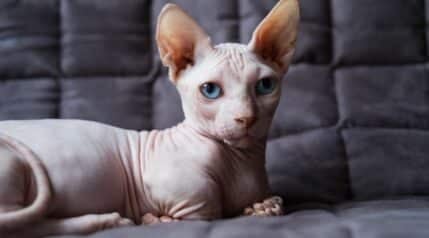When you purchase through links on our site, we may earn a commission. Here’s how it works.
The Siamese Tabby mix is a cat of many names: Tabby Point Siamese, Lynx Point Siamese, and Lynx Colorpoint Shorthair. As a relatively new Siamese mix, cat breeder associations have debated on how to categorize this Siamese evolution. The International Cat Association (TICA) includes the Lynx Point Siamese in its Siamese breed standard. Other registries, like the Cat Fanciers’ Association (CFA), do not recognize the lynx-point pattern in the Siamese breed and instead place this cat into a separate breed classification called the Colorpoint Shorthair. The Colorpoint Shorthair breed is essentially the Siamese cat in additional coat colors and patterns outside the traditional four colors (blue, chocolate, lilac, and seal).
The Siamese Tabby mix has all of the characteristics we love about the Siamese cat—friendliness, intelligence, elegance, and vocality—mixed with the markings of the domestic tabby cat. The Lynx Point Siamese comes in color patterns, including blue, blue-cream, chocolate, chocolate-tortie, cream, lilac, lilac-cream, red, seal, and seal-tortie.
Breed History
The Tabby Point Siamese encapsulates two recognizable looks within the world of cats: the Siamese and the tabby. This feline’s history goes back to the 1940s and 1950s, when breeders began experimenting with different coats for the Siamese cat. Breeders attempted to create a Siamese feline with red points instead of the traditional blue, chocolate, lilac, or seal colors. According to the CFA, a seal point Siamese was eventually bred to a red tabby American Shorthair to create the first Colorpoint Shorthair cat. This litter began the Colorpoint Shorthair breed.
Siamese Cat History

As one of the most recognizable cat breeds in the world, the Siamese is known for their svelte bodies, colorpoint coats, wedge-shaped heads, and vibrant blue eyes. Fondly referred to as Meezers, this ancient breed is believed to have originated in what was once called Siam, known today as Thailand. The cat first appeared in a Thai manuscript around the 14th century, making it one of the oldest cat breeds worldwide.
Legend says the Siamese were cherished temple cats to the King of Siam. The felines were assigned the duty of guarding the king and would perch atop columns around the king’s throne, ready to attack anyone who tried to threaten the king. Another legend says that a group of Siamese cats guarded a golden goblet. So diligent were the cats to their duty that their eyes became crossed from watching the goblet, and their tails became bent from wrapping the appendage around the goblet for extra security.
It’s true that for a long time, many Siamese cats had crossed eyes and kinked tails. Despite legends offering other explanations, it is believed these traits resulted from genetic factors. These traits were considered undesirable by breeders, and selective breeding has reduced the crossed eyes and crooked tails once commonly found in this breed.
As the breed’s popularity grew, so did interest in diversifying the breed. The 1940s and 1950s say breeders experimenting with coat colors and patterns. Towards the 1960s, the Siamese began to take on a more slender look. The traditional Siamese, also called the Thai cat, Old-Style Siamese, or Wichien Maat, had a thicker body and a rounded head. In contrast, the modern Siamese appears thin with a wedge-shaped head. Today, cat associations favor the modern Siamese look.
The Siamese is medium-sized with a short, soft coat. A genetic mutation resulted in the color-point coat of the Siamese cat, where there is a defined contract between the body and extremities. We love these chatty cats their intelligence and affectionate personalities.
Tabby Cat History

The tabby isn’t a separate breed but is actually a pattern seen in a cat’s coat. The tabby pattern, which is in 80 percent of present-day cats, can be blotches, spots, stripes, or swirls. While these cats are extremely popular, until recently, we’ve not known how these cats got their stripes.
A 2021 study, first published by Nature Communications and reported by National Geographic, shows that the tabby pattern is visible in embryonic cells. Skin cells of embryos that were 25 to 28 days old showed a color pattern comparative to the coloring of an adult tabby, all before the presence of hair follicles and pigment.
Tabby cats can be found in five distinct patterns:
- Classic: Also called the blotched tabby, the classic tabby cat has a pattern of swirls along the sides of their body.
- Mackerel: The mackerel tabby sports a coat of unbroken stripes like a tiger. Ideally, the stripes branch out from one stripe that runs down the cat’s spine, resembling a fish skeleton, hence the name “mackerel.”
- Spotted: These cats have round, oval, or rosette spots throughout their coat. The spots may appear similar to stripes but are broken, thus appearing more like spots.
- Ticked: Ticked tabbies may have stripes or bands on their legs or tails, but their bodies will be free of markings. These cats will also have the tabby face markings found in all varieties. You can always tell a tabby by the “M” mark on their forehead.
- Patched: Used to describe a tortoiseshell tabby (torbie), the patched tabby may have any tabby markings along with separate patches of color.
Temperament
If you’re looking for a very opinionated roommate, the Siamese Tabby is for you. Cat enthusiasts know the Siamese for being social, friendly, and vocal. These kitties love attention and tend to bond strongly with one person. Like the Siamese, the Siamese Tabby loves to be loved and may experience separation anxiety if left alone for too long. This highly active cat enjoys running, climbing, and playing. They thrive in families that can give them lots of playtime and cuddles.
Size & Appearance
Like the Siamese, the Siamese Tabby mix is a medium-sized athletic cat with a lithe but muscular body. Overall, this cat has a long, graceful appearance with a long, tubular body and fine boning. You can expect a Siamese Tabby six to 14 pounds and up to 24 inches long. The Siamese Tabby has a wedge-shaped head, starting at the nose and flaring out in straight lines to the tips of the ears, giving this cat a triangular shape. This cat has a long, straight nose, fine muzzle, and huge ears. Their almond-shaped eyes are a deep, striking blue and slant toward their nose. The tail of the Siamese Tabby is long and thin, tapering to a fine point.
Coat & Colors
The coat of the Siamese Tabby is short, tight, close-lying, and fine. This colorpoint kitty is identical to the Siamese but with different colors and patterns. The Siamese Tabby mix may be blue, blue-cream, chocolate, chocolate-tortie, cream, lilac, lilac-cream, red, seal, and seal-tortie.
The Siamese Tabby is called “lynx point,” a term that describes any colorpoint cat in which the tabby pattern is visible on the darker areas of the cat’s coat. As their name suggests, a standard colorpoint would have a light-colored body with darker points (face, legs, and tail). In a lynx point, those darker points will also have a tabby pattern. A Siamese Tabby will have the tabby “M” marking on their face and vivid blue eyes.
Grooming
The coat of the Siamese Tabby is short, glossy, and easy to maintain. Use a soft-bristle brush or grooming mitt once a week to remove loose hair and keep their coat shiny. Felines are famously fastidious groomers, and you may never need to bathe your Siamese Tabby. If you find that your cat needs an occasional bath, always use pet-specific products to prevent irritating your cat’s delicate skin.
Your feline will likely need their nails trimmed every few weeks. Nail care is a crucial grooming step, especially for indoor cats. Without regular trimming, your cat’s nails may crack or break, leading to pain and infection. Long term, nail overgrowth can cause mobility issues and chronic pain. Use a durable nail trimmer to make the process quick and painless.
For sassy cats, you may need to find a partner to hold your cat while you’re trimming. The burrito method, where you wrap your cat in a towel to prevent biting and scratching, can be effective for extra fiery cats. Talk to your veterinarian if you’re unable to cut your cat’s nails safely. Many veterinary clinics offer services for nail clipping.
Check inside your cat’s ears every so often for signs of dirt or debris. Clean dirty ears with a pet ear cleanser and cotton ball. If the ear looks inflamed or you notice your Tabby Point shaking their head or scratching their ears, schedule a visit with your veterinarian to rule out infection or ear mites.
Prevent damage to your cat’s gums and teeth with regular brushing. With all grooming, make sure to reward your cat with treats for a job well done.
Living Requirements
Like all housecats, the Siamese Tabby mix requires a food, water, a litter box, a few scratching posts, and lots of toys. Provide plenty of space for your cat to hide, run, jump, play, and rest. This social cat needs plenty of one-on-one time. Schedule regular playtime with your cat to keep them fit and happy. Because the Siamese breed tend to get separation anxiety, familiarize yourself with the signs of anxiety and loneliness in cats. There are many ways to support a stressed feline, including environmental enrichment, interactive play, and even prescription medications and supplements.
Exercise & Training
Your Siamese Tabby mix will likely be curious and very intelligent. These agile kitties don’t need any persuation to play. Make sure your cat has plenty of room for exercise. If you find that your cat is putting on weight, explore more opportunities for play throughout the day.
The Siamese breed tends to accept training better than other breeds, and the Siamese Tabby is no different. Your feline will catch on quickly to basic training and is a great candidate for advanced training. Teach your cat to sit, stay, high-five, roll over, and walk on a leash.
Health & Lifespan
The life expectancy of a Siamese Tabby is eight to 12 years. This cat is at risk for the same health issues seen in the Siamese breed:
- Amyloidosis
- Cancer (lymphoma, mast cell tumors, thymoma)
- Crossed eyes
- Feline Hyperesthesia Syndrome
- Hip dysplasia
- Hypertrophic Cardiomyopathy
- Mouth and gum disease
- Lysosomal storage diseases
- Pica
- Progressive Retinal Atrophy
- Renal Amyloidosis
- Separation Anxiety
- Sinus and respiratory problems
If you wish to buy a kitten, selecting a cat from a responsible breeder will ensure your cat is healthy and well-adjusted. Reputable catteries will screen their parent cats for genetic diseases to minimize the risk of producing cats with future breed-related health problems.
Nutrition
The Siamese Tabby doesn’t have any specific nutritional needs. As for all cats, look for a high-quality food recipe from multiple protein sources. Ideally, feed your cat wet food, which will provide extra hydration. For kibble, look for a grain-free formula that’s free of vaguely named animals and by-products, artificial colors and flavors, and filler ingredients. Supplement omega-3 fatty acids from fish oil for an extra-shiny coat and anti-inflammatory support. Clean, fresh water should always be available to your cat.
The active lifestyle of the Siamese Tabby means it’s less likely to pack on the pounds. Still, we don’t recommend free feeding your cat. Instead, provide two or more small meals throughout the day. Your veterinarian can recommend healthy food for your Siamese Tabby.
Breeder & Kitten Costs
Buying a Siamese Tabby from a breeder will cost anywhere between $200 to $400. Always buy from a reputable breeder to avoid health and behavioral problems.
Rescues & Shelters
While the Siamese is a popular breed, you’ll likely have difficulty finding a Siamese Tabby to adopt at your local shelter. For the rescue-minded pet parent, try searching online for adoptable cats or look for breed-specific cat rescue organizations. Petfinder is a great adoption website that allows you to filter for breed and location.
As Family Pets
The Siamese Tabby mix makes a fantastic family pet. This cat loves attention and will thrive in an active household. This feline is suitable for families with young children, as well as multi-pet households. This cat loves cuddle time, so make sure you aren’t away from home too often. If left alone too often, your cat may exhibit separation behaviors like loud meowing or peeing outside the litter box.
Final Thoughts
Learn about other Siamese mixes, including the Siamese Maine Coon, Siamese Calico, and Siamese Persian. We also cover a variety of tabby mixes, including the Abyssinian Tabby, Bengal Tabby, and Ragdoll Tabby.





